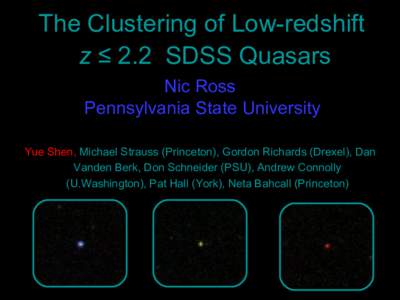 Date: 2015-07-01 19:27:10Astronomy Physical cosmology Quasar Radio astronomy Redshift Galaxy Physics Astronomical surveys Sloan Digital Sky Survey Redshift quantization | |  The Clustering of Low-redshift z ≤ 2.2 SDSS Quasars Nic Ross Pennsylvania State University Yue Shen, Michael Strauss (Princeton), Gordon Richards (Drexel), Dan Vanden Berk, Don Schneider (PSU), Andrew Connolly The Clustering of Low-redshift z ≤ 2.2 SDSS Quasars Nic Ross Pennsylvania State University Yue Shen, Michael Strauss (Princeton), Gordon Richards (Drexel), Dan Vanden Berk, Don Schneider (PSU), Andrew Connolly
Add to Reading ListSource URL: sdss2008.uchicago.eduDownload Document from Source Website File Size: 2,44 MBShare Document on Facebook
|

